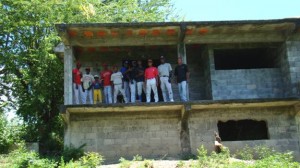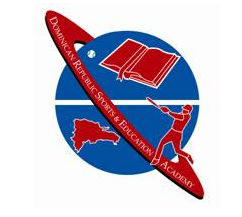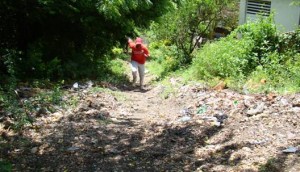Volume III, Issue 13: A Publication For Your Reading Enjoyment
Like thousands of other boys and young men in the Dominican Republic, Edgar Ferreira chased the dream of baseball most of his life. And, just like thousands of others, the chase went unfulfilled, ending far short of the big league career he had envisioned.
I first met Edgar a few months ago in a chance encounter along the roadside near his home, a ramshackle dwelling he shares with eight people. Now in his early 20’s, he said his big league dreams began when he was about eight. As his pitching skills developed, and his fastball exceeded 90 miles an hour, he attracted the attention of several buscones, the flesh peddlers who auction off young prospects to the highest bidders, but he failed to latch onto a team at 16, the magical signing age for top prospects in the country.

As he got older, the ticking clock eroded his value and by age 19 the sands of time were beginning to run out. One team offered him $3,500 to sign, another $8,500; mere pittance in a country where the average signing bonus is $100,000. But when a buscone convinced him to lie and shave two years off his age, Edgar signed with the Anaheim Angels for $75,000, a sum he said he had to split 50-50 with his broker and others. When the lie unraveled, he was cut from the team.
He got one more shot with the San Diego Padres, but a medical exam revealed problems in his throwing arm. Nobody wants a pitcher with a bad wing; the dream shriveled like a raisin in the hot Dominican sun.
But Edgar had seen the promised land and now believes he can lead others there, help them to obtain the career that eluded him, and on the day I visited him again, he eagerly shows off a rag-tag platoon of recruits, about a dozen young men in baseball uniforms eager to take up the challenge.
He has them charge up a steep incline cut into the overgrowth on a hill near his home by the repetitions designed to improve leg strength. Edgar’s prospects strain to reach the crest of the hill. We used to call them suicide drills when I played sports; that which doesn’t kill you, makes you stronger.
- Running the hill: photo taken from the DREAS INFORMER
The dreamers move on to a makeshift batting cage of netting strung between trees. Sand carted from the nearby beach provides a carpet as Edgar tosses batting practice with balls so worn that many are without covers. The crack of the aluminum bat echoes over the hillside.

Edgar’s charges now take a turn in his gym, complete with weights constructed from steel rods anchored at both ends with cement set in tomato cans. Edgar’s “training camp” is a true example of Dominican ingenuity.

We later trek down a steep, rocky road and cross a dry stream bed to a baseball field crudely cut into the terrain. A bull is tethered nearby; a single white crane keeps him company. It is here Edgar reflects on his own baseball journey and how it fell short. The buscone who encouraged him to lie has dropped out of sight, probably moving on to help another boy who shows potential.
Of his recruits, Edgar believes a couple have what it takes to succeed in baseball; one of them is so dedicated he dropped out of school to chase the brass ring. Edgar does not charge for his training; if one of his students signs, he says he will take only 20 percent of the bonus.
In the afternoon, after school lets out, another group comes to Edgar’s camp. These 8- to 12-year-olds form his second tier of prospects, and all share the dream of becoming big league players. Ask them their favorites and they shout out the names of Dominican stars: Pedro, Soriano, Pujols, Big Papi; there is no shortage of role models for them.
It is here that sadness and frustration overwhelm me. Sadness that all of these dream chasers share not only a passion for baseball but also the poverty that fuels the dream. Baseball in the Dominican Republic depends on that passion, that lure, that pursuit of a game so intoxicating that people will lie about their age, will take steroids to become bigger, faster and stronger, will abandon school for a chance at stardom, for a chance to escape poverty. But in reality, only a precious few ever achieve the stardom the dream merchants offer.
I see the faces of so many who can benefit from what the Dominican Republic Sports & Education Academy has to offer; a chance to use their baseball skills to compete for college scholarships in the United States, to obtain an education, to use their minds to flee poverty. The frustration is that for some, the DRSEA will become a reality too late to help them.
I am quickly approaching two years living in the Dominican Republic and I had hoped we would be closer to bricks and mortar than we are. But if I have learned nothing else living here, I understand that things take time – and we are making progress.
We are looking at three separate site locations, and determining which suits the DRSEA best, both in terms of location and acquisition. Our curriculum is being fined-tuned, so that we can offer courses that will not only prepare DRSEA graduates to succeed in U.S. colleges and universities, but to excel.
We have a stack of resumes from qualified individuals eager to teach and/or coach at the academy. Inquiries come in from all over the world from young boys and parents wanting to know about enrollment. Colleges baseball coaches are also inquiring, many with specific requests for a pitcher, or a third baseman, knowing that a Dominican talent infusion could turn a good baseball team into a great one.
The media has shown an interest – particularly as reform in Dominican baseball ramps up – and the DRSEA and the education it will provide are being viewed as part of the solution.
So I find myself caught between the progress we have made and the distance we still have to go, the money we have to raise to put the bricks in place, to pay teachers and coaches, to take care of baseball fields and dormitories, to outfit classrooms, to make the DRSEA a world class academic and athletics facility. And the economic climate here and in the United States is not making things any easier.
I often feel like my clock is ticking as well; that I am not moving fast enough to help kids like those in Edgar’s camp, and yet I know that I can’t stop now, no matter how long it takes.





A terrific story of humble beginnings to pursuing a dream. Well done and keep going!!